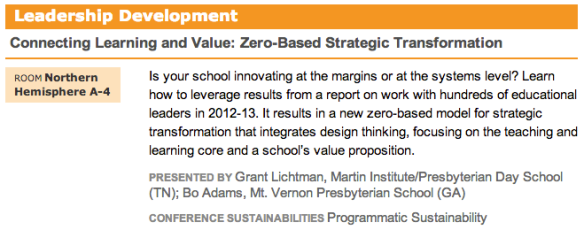After a few days of reflecting on #NAISAC13 (the National Association of Independent Schools’ Annual Conference 2013), I am hopeful!
From the general sessions that NAIS curated, I cannot imagine that there could be much confusion about core message – schooling and education are experiencing a grand revolution, and NAIS schools can be leaders or left behind in this revolution. It’s a choice.
Jim Collins reprised his strong thoughts on Good to Great and Great by Choice. He was clear that level 5 leadership builds “enduring greatness through a paradoxical blend of personal humility and professional will.” He reminded us that mediocrity comes more often from chronic inconsistency than resistance to change. He implored us – new initiatives piled on are not the answer. Rather, knowing who you are, discerning with creativity what you can do of greater value than anyone else, and remaining disciplined about marching to that highest trajectory of yourself are the x factors of great success. Finally, Collins stressed that organizations must preserve their core values while adapting their practices on the march to greatness. The big problem, though, is that many organizations confuse their values and their practices. So, clarity of purpose and identity and character is a must.
Heads of school such as Nishant Mehta (soon to be a head of school at The Children’s School in Atlanta; currently at Alexandria Country Day School), Bill Taylor (St. George’s in Memphis), Matt Glendinning (Moses Brown School in Rhode Island), Jonathan Martin (former head at St. Gregory Preparatory School in Tucson), and Brett Jacobsen (Mount Vernon Presbyterian School in Atlanta) shared their stories with us about the work that school leaders must do to innovate school cultures and to reposition the practices of schools so that we are immersing learners in experiences that will help them grow as communicators, innovators, creative contributors, critical thinkers, collaborators, and solutions finders. Along with acclaimed journalists, consultants, and educators like Suzie Boss, Ken Kay, Chris Thinnes, and Grant Lichtman, the messaging in the workshops was as consistent and clear as that in the general sessions – the world is changing at an ever quickening rate, and we must re-imagine schools and implement transformation so that our learners can be in more project-based, design-oriented, community-engaged, and world-relevant organizations.
There were countless connecting threads emphasizing the importance and power of networked approaches to school transformation. Ken Kay explained the professional learning community EdLeader21, composed of 111 school districts and independent schools. Suzie Boss recapped her research, in her book Brining Innovation to Schools (see here, here and here), on the stellar models across the country of schools transforming for the demands of our times. Grant Lichtman shared his findings from visiting 64 schools in 12 weeks, looking for exemplars of school innovation. He detailed that schools that struggle with change tend to grapple with anchors, dams, and silos. Schools that embrace innovation model dynamism, adaptability, permeability, relevance, self-correction, and creativity. Grant challenged the notion that school innovation was just about looking forward, and he said that his findings could be summarized on one word – Dewey. The essence of school transformation calls on the tenets of the progressive education movement. Outgoing president of NAIS Pat Bassett echoes similar chords every time he speaks, too. Just look at his TEDx talk on the “Big Shifts” and paste those up next to a synopsis of progressive education.
Terarai Trent inspired us to never give up on a mission to help all people connect with the education that they deserve as human beings.
Cathy Davidson closed the conference with a final keynote that reinforced several pillars holding up an overarching theme: kids today know that there is a significant mismatch between school and the way we learn in real life. In more detail, she emphasized five main ideas:
- Rethink liberal arts as a start-up curriculum for resilient global citizens.
- Move from critical thinking to creative contribution.
- Make sure what you value is what you count.
- Find creative ways to model un-learning.
- Take institutional change personally.
At least for my experience at #NAISAC13, there was great consistency and conviction in the messages. In fact, to me, the different voices were essentially singers in the same chorus.
To help me reflect this week, I reviewed ALL of the tweets from #NAISAC13. I packaged my own story of those tweets in a Storify. [View the story “NAISAC13” on Storify]
I’d be interested to hear other people’s primary take away, but mine was clear: schools must change, and in ways that empower students to be creative contributors and interested innovators and caring citizens.

The printed theme of #NAISAC13 was “Revolutionary Traditions: Think Big, Think Great.” But I believe we’ve been thinking about this stuff long enough. Revolutions require more action, move movement, more doing. The theme was not “resolutions,” but “revolutions.” The place was Philadelphia.
In reality, I think NAIS and the leaders gathered there communicated an even more powerful and hopeful theme: “Act Big, Be Great.” I’m so grateful for those who are DOING so.
= = =
And this from an email sent by NAIS after the conference:
Dear Colleague,
Thank you so much for joining us in Philadelphia for the 2013 NAIS Annual Conference. The spirit and great attitude of everyone in attendance will certainly spark our imaginations to revolutionize our schools – and the future of education.
Looking for more information to continue learning and brainstorming? Here’s just a sampling of what you’ll find on the NAIS Annual Conference website as we continue to update it during the next two weeks:
- JPGs of the graphic recordings that the artists illustrated during the general sessions and featured workshops;
- Interviews with many of the conference speakers;
- Workshop handouts/presentations;
- Articles about the general session and featured workshop speakers;
- Videos of Sekou Andrews, Danah Boyd, Soumitra Dutta, and Alexis Madrigal;
- And more!
Check the site regularly as we continue to add new materials.






